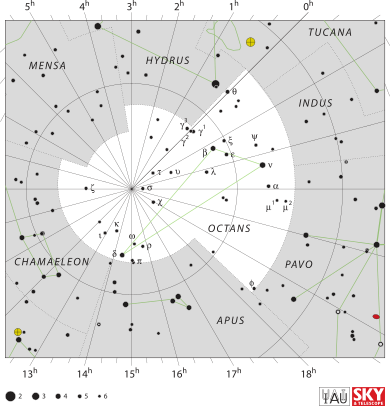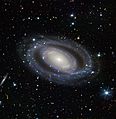Octans facts for kids
| Constellation | |

List of stars in Octans
|
|
| Abbreviation | Oct |
|---|---|
| Genitive | Octantis |
| Pronunciation | genitive |
| Symbolism | the Octant |
| Right ascension | 22 |
| Declination | −90 |
| Quadrant | SQ4 |
| Area | 291 sq. deg. (50th) |
| Main stars | 3 |
| Bayer/Flamsteed stars |
27 |
| Stars with planets | 2 |
| Stars brighter than 3.00m | 0 |
| Stars within 10.00 pc (32.62 ly) | 1 |
| Brightest star | Nu Octantis (3.73m) |
| Messier objects | none |
| Meteor showers | none |
| Bordering constellations |
Tucana Indus Pavo Apus Chamaeleon Mensa Hydrus |
| Visible at latitudes between +0° and −90°. Best visible at 21:00 (9 p.m.) during the month of October. Circumpolar. |
|
Octans is a special group of stars, also known as a constellation, found in the very south of our sky. It's named after a tool called an octant. An octant was used by sailors long ago to figure out where they were by looking at the stars. Imagine it like an old-fashioned GPS!
This constellation is quite faint, meaning its stars aren't very bright. It's hard to see without a telescope or binoculars. Octans is unique because it contains the star closest to the South Celestial Pole, which is like the South Pole of the sky. This star is called Sigma Octantis (σ Octantis). It's not very bright, so it's not easy to spot.
Contents
What is Octans?
Octans is one of the 88 modern constellations that astronomers recognize today. It's located in the Southern Hemisphere, which means you can only see it if you are south of the Equator. It's known for being the southernmost constellation in the sky.
The name "Octans" comes from the Latin word for "octant." An octant is a navigation tool that sailors used to measure the angle between the horizon and a celestial body, like a star or the Sun. This measurement helped them figure out their ship's latitude (how far north or south they were).
History of Octans
Octans is a relatively new constellation. It wasn't known to ancient civilizations because it's so far south. It was first described by a French astronomer named Nicolas-Louis de Lacaille in the 1750s. He explored the southern skies and named many new constellations.
Lacaille created Octans to honor the octant, a very important tool for exploration during his time. He named many constellations after scientific instruments, like the telescope (Telescopium) and the microscope (Microscopium). This shows how much he valued science and discovery.
Stars in Octans
Octans is not a constellation with many bright stars. Most of its stars are quite dim. The brightest star in Octans is called Nu Octantis. Even though it's the brightest, it's still not easy to see with the naked eye from Earth.
The most famous star in Octans is Sigma Octantis (σ Octantis). This star is special because it's the closest star to the South Celestial Pole. This pole is the point in the sky around which all the stars in the Southern Hemisphere appear to rotate. Think of it like the North Star (Polaris) for the Northern Hemisphere, but much fainter. Because Sigma Octantis is so close to the South Pole of the sky, it's often called the "South Pole Star." However, it's so dim that it's not very useful for navigation, unlike the North Star.
Finding Octans in the Sky
Since Octans is in the far southern sky, you need to be in the Southern Hemisphere to see it. It's a circumpolar constellation for observers in the deep south. This means it never sets below the horizon and is always visible in the night sky, circling around the South Celestial Pole.
To find Octans, you would typically look for the South Celestial Pole. Since Sigma Octantis is very faint, sailors often use other, brighter constellations like the Southern Cross (Crux) and Centaurus to help them point towards the South Celestial Pole, and then they can try to locate Octans nearby.
What's in Octans?
Besides its stars, Octans doesn't have many famous deep-sky objects like bright galaxies or nebulas that are easy to see. It's mostly known for its unique position as the southernmost constellation and for containing the South Pole Star.
Astronomers still study the stars and objects within Octans to learn more about our universe. Even faint constellations can hold interesting secrets about how stars form and evolve.
Images for kids
See also
 In Spanish: Octans para niños
In Spanish: Octans para niños



